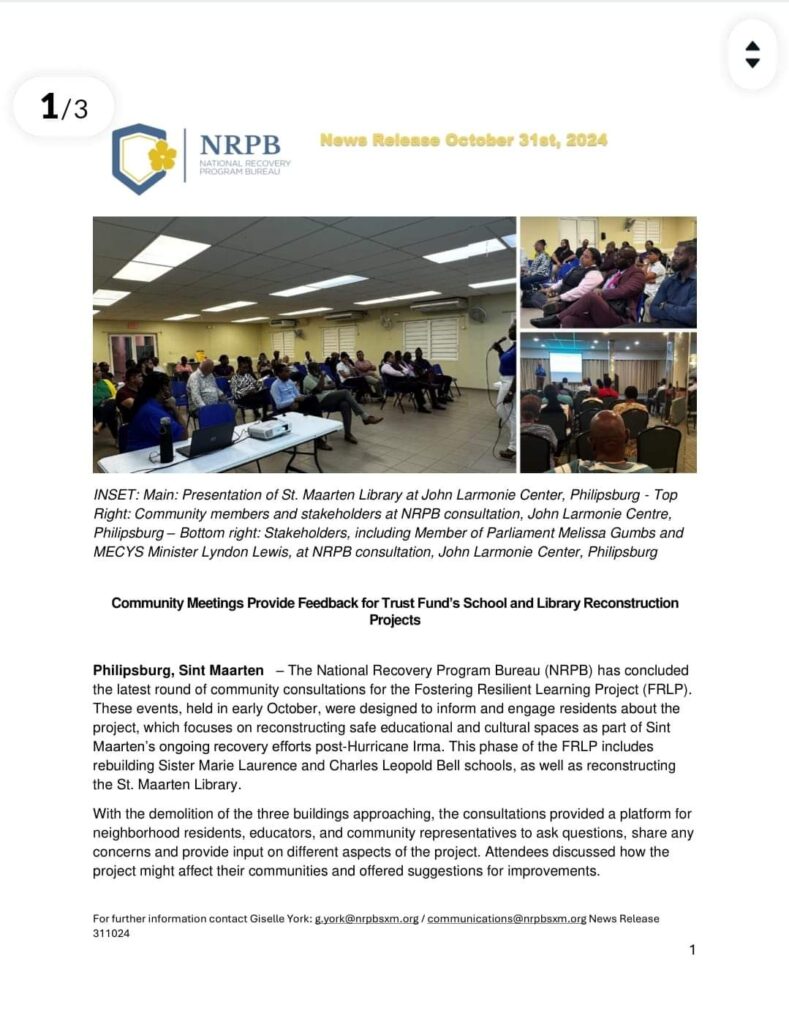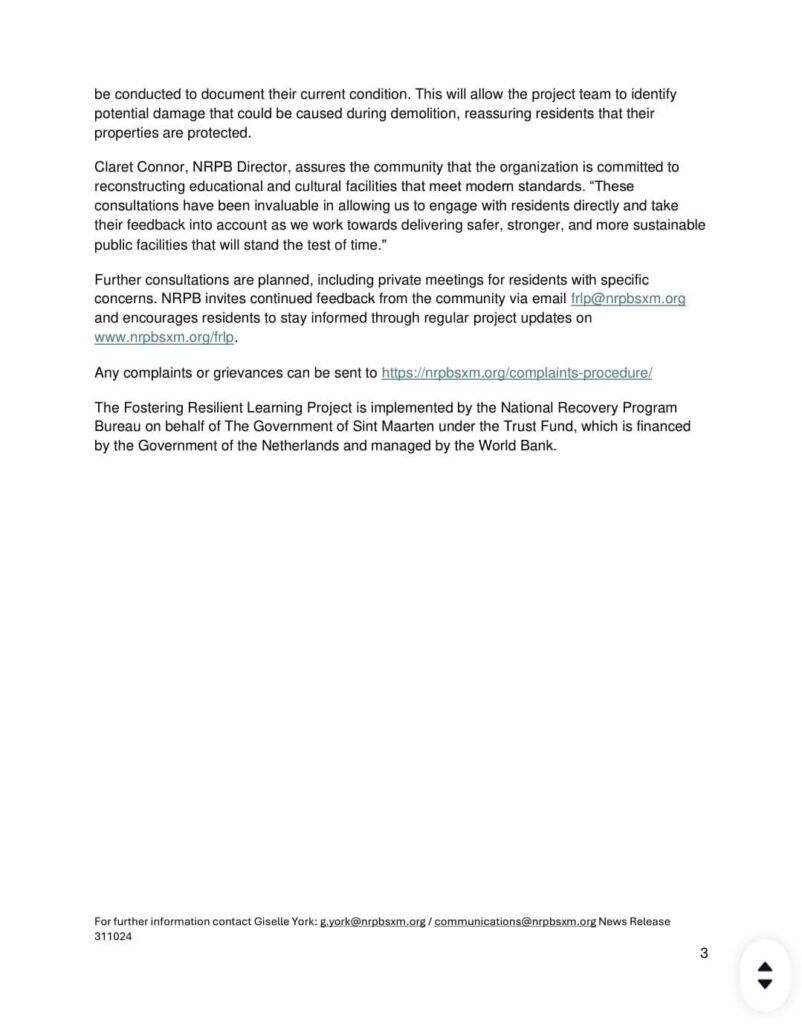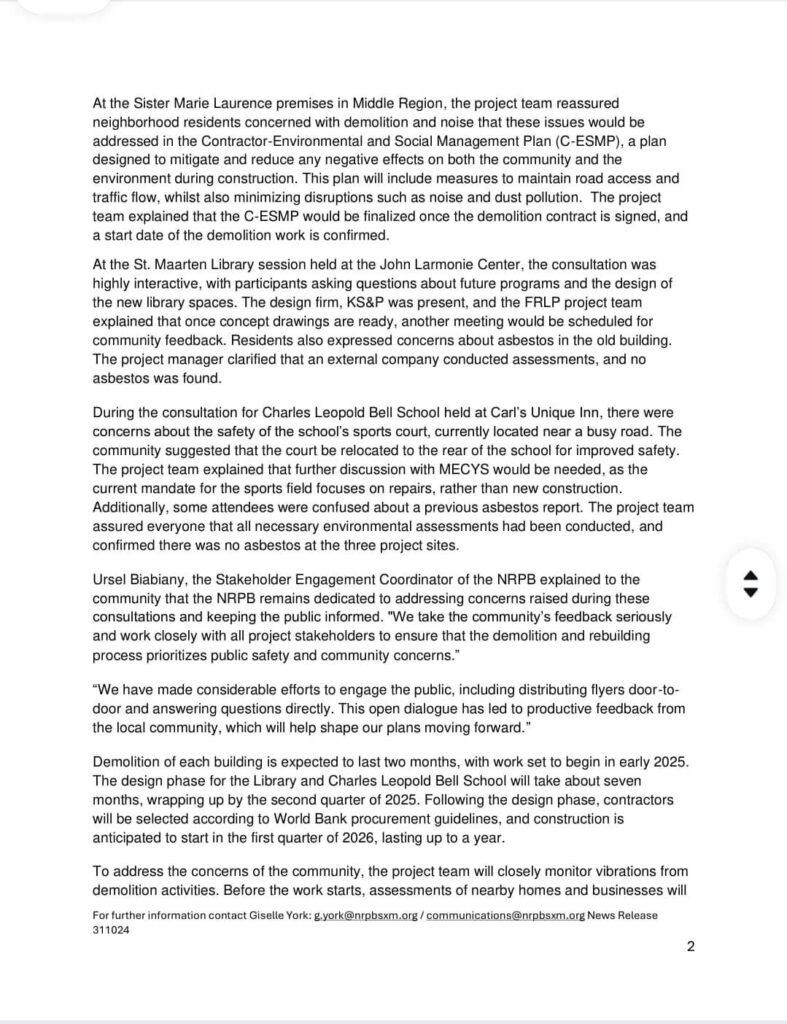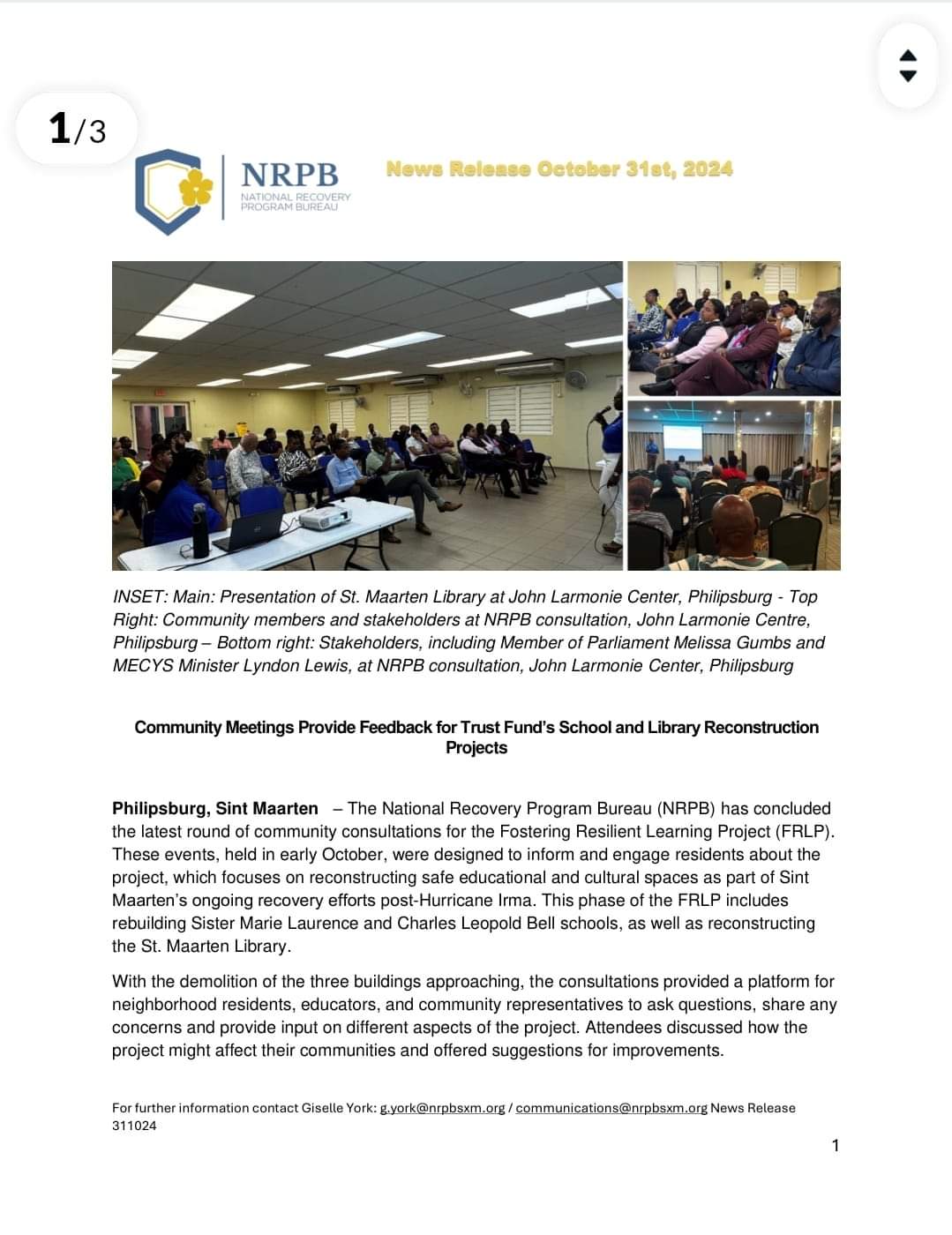Community Meetings Provide Feedback for Trust Fund’s School and Library Reconstruction Projects

https://sxmnews.ai/french-st-martiner-going-to-dutch-prison-for-stabbing/
Meetings Provide Feedback for Trust Fund’s School and Library Reconstruction Projects
The History of the NRPB in St. Maarten
The National Recovery Program Bureau (NRPB) emerged in St. Maarten following the devastation of Hurricane Irma in September 2017.
This category 5 hurricane battered the island, damaging nearly 90% of its structures and causing massive disruptions in infrastructure,
housing, health, education, and local government operations.
The aftermath left St. Maarten with an urgent need for extensive and coordinated recovery efforts.
In response, the Kingdom of the Netherlands, the Government of St. Maarten, and the World Bank established a collaborative recovery framework,
initiating the formation of the NRPB as a critical part of this framework.
Founding and Mission of the NRPB
The Government of St. Maarten formally established the NRPB in 2018 as the primary agency responsible for managing, coordinating, and implementing recovery and resilience projects.
Meetings Provide Feedback for Trust Fund’s School and Library Reconstruction Projects
It designed the NRPB to operate as a semi-independent agency, reporting directly to the Council of Ministers while working closely with stakeholders and international partners.
The NRPB’s mission focuses on rebuilding a stronger, more resilient St. Maarten and preparing the island for future natural disasters.
It manages the strategic allocation of funds from the St. Maarten Trust Fund, a $580 million fund that the Netherlands provided and the World Bank administers.
Setting Up the St. Maarten Trust Fund
To ensure accountability and transparency, the Kingdom of the Netherlands partnered with the World Bank to create the St. Maarten Trust Fund.
They decided that the World Bank would manage the fund due to its expertise in large-scale recovery and development efforts worldwide.
This structure aimed to safeguard the fund’s efficient use, reinforcing effective governance and minimizing corruption risks.
With the fund established, the Government of St. Maarten tasked the NRPB with identifying, planning, and executing projects across various sectors.
They selected sectors based on urgency and the potential to improve citizens’ lives, rebuild critical infrastructure, and enhance economic stability.
By placing the NRPB in charge, the government aimed to centralize recovery efforts under one organization,
improving coordination, avoiding duplication, and streamlining reporting procedures.
Early Challenges and Adjustments
In its early stages, the NRPB faced numerous challenges, including bureaucratic hurdles, regulatory constraints, and logistical issues.
Staff worked to secure permits, navigate procurement processes, and ensure compliance with both local and World Bank standards.
Meanwhile, the public pressured the NRPB to deliver visible results quickly, adding urgency to an already complex mandate.
To overcome these challenges, the NRPB adjusted its internal structures and operational strategies.
It increased collaboration with local stakeholders, from government agencies to community organizations, and streamlined its processes.
This proactive approach allowed the NRPB to expedite project implementation without compromising on quality or accountability.
Meetings Provide Feedback for Trust Fund’s School and Library Reconstruction Projects
Key Initiatives and Milestones
The NRPB quickly prioritized initiatives that addressed urgent needs, such as housing, infrastructure, and healthcare.
For instance, in collaboration with the Ministry of Public Housing, Spatial Planning, Environment and Infrastructure (VROMI),
the NRPB launched a series of housing projects aimed at repairing and rebuilding homes that Irma damaged.
These efforts sought to provide safe, resilient housing for St. Maarten’s most vulnerable residents, including low-income families and seniors.
Community Meetings Provide Feedback
One of the NRPB’s early landmark projects involved the reconstruction of the Princess Juliana International Airport (PJIA).
As the main entry point for international visitors, the airport plays a crucial role in St. Maarten’s tourism-driven economy.
The NRPB allocated funds from the Trust Fund to repair and upgrade the airport, enhancing its resilience to future storms and ensuring uninterrupted operations.
In the healthcare sector, the NRPB invested heavily in rebuilding and upgrading the St. Maarten Medical Center (SMMC).
After Hurricane Irma, medical services suffered from limited facilities and resources,
prompting the NRPB to prioritize the hospital’s expansion and modernization.
By upgrading SMMC’s infrastructure,
the NRPB aimed to improve local healthcare capacity and reduce the island’s dependency on external medical services.

The NRPB also focused on strengthening education. Community Meetings Provide Feedback
It initiated projects to rebuild schools, repair damaged classrooms, and improve educational facilities.
The bureau collaborated with the Ministry of Education, Culture, Youth,
and Sports to ensure that these efforts aligned with national education standards and addressed the specific needs of students and teachers.
By focusing on these essential services,
the NRPB contributed to long-term community resilience and helped restore normalcy to the daily lives of St. Maarten’s residents.
Resilience and Disaster Preparedness
While reconstruction remained a priority, the NRPB also recognized the importance of preparing for future disasters.
In partnership with the World Bank and other international organizations,
the NRPB implemented projects that aimed to enhance St. Maarten’s disaster resilience.
For example, it invested in infrastructure that could withstand hurricanes and floods, such as storm-resistant public buildings, reinforced coastal defenses, and improved drainage systems.
The NRPB also promoted community-based disaster preparedness.
It collaborated with local organizations to create public awareness campaigns that encouraged residents to take proactive steps in disaster readiness.
These campaigns taught residents about emergency planning, securing homes, and accessing essential resources.
By promoting a culture of preparedness,
the NRPB aimed to reduce the risk of catastrophic damage in the event of future hurricanes or natural disasters.
Financial Management and Accountability
Throughout its operations, the NRPB maintained a strong focus on financial management and accountability. The bureau worked closely with the World Bank to establish stringent protocols that governed fund allocation, procurement, and project management. Every project funded by the St. Maarten Trust Fund required comprehensive planning, detailed budgeting, and continuous oversight to ensure that the funds were used effectively and transparently.
Meetings Provide Feedback for Trust Fund’s School and Library Reconstruction Projects
The NRPB developed a rigorous reporting framework, providing regular updates to both the Government of St. Maarten and the World Bank.
By adhering to these protocols, the NRPB fostered trust among its stakeholders and demonstrated its commitment to responsible financial stewardship.
This accountability reassured the public that recovery funds were being used appropriately and efficiently.
Long-Term Impact and Vision
Since its inception, the NRPB has made significant strides in helping St. Maarten recover from Hurricane Irma and build a more resilient future. The bureau’s projects have created a positive, tangible impact on the island’s infrastructure, healthcare, education, and housing sectors.
As it continues to work toward the island’s recovery, the NRPB remains committed to fostering resilience, improving disaster preparedness, and promoting sustainable development.
Meetings Provide Feedback for Trust Fund’s School and Library Reconstruction Projects
Looking ahead, the NRPB envisions a St. Maarten that can withstand the challenges of future natural disasters and thrive as a resilient, prosperous community.
The bureau aims to complete its current recovery projects while laying the foundation for sustainable economic growth and social development.
By working closely with the Government of St. Maarten, the World Bank, and local communities,
the NRPB strives to ensure that its efforts contribute to a lasting legacy of resilience and renewal for St. Maarten.
Conclusion
The NRPB’s history reflects the resilience of St. Maarten and the determination of its people to rebuild after disaster.
From its establishment in response to Hurricane Irma’s devastation to its current role as a leader in recovery and resilience,
the NRPB has played an essential role in the island’s journey toward stability and growth. Its efforts in housing, infrastructure, healthcare, education,
and disaster preparedness have transformed the landscape of St. Maarten, preparing the island to face future challenges with strength and optimism.
The NRPB’s legacy continues to unfold, shaping a brighter future for generations to come in St. Maarten.
Meetings Provide Feedback for Trust Fund’s School and Library Reconstruction Projects

Community Meetings Provide Feedback

